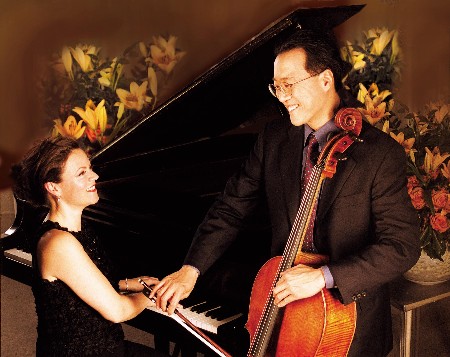Classical Music Review: Yo-Yo Ma

Cellist Yo-Yo Ma and pianist Kathryn Stott
Reviewed By Caldwell Titcomb
Yo-Yo Ma is the greatest living cellist. Now 54, he has been playing the cello for 50 years amassing a huge number of awards and other honors along the way. The Celebrity Series coaxed him home from his world-wide touring for a sold-out Symphony Hall recital on March 26 with British pianist Kathryn Stott as his collaborator.
The choice of program was nicely wrought. Two standard 19th-century pieces in the key of A enclosed a batch of less familiar works from the 20th century. The concert began with Schubert’s Sonata , D. 821, known as the “Arpeggione Sonata” (1824).
The arpeggione, invented in 1824 by Johann Georg Staufer, was a fretted instrument with six strings tuned like a guitar. The strings were mounted over a curved bridge, and the instrument was played with a bow like a cello. It didn’t catch on, and the piece Schubert was asked to write for it is the only notable work it engendered. This lovely three-movement sonata has attracted players of several instruments, but it is most widely heard as a vehicle for the cello. Ma and Stott provided the best interpretation of the many in my experience.
Next came Shostakovich’s “Sonata in D Minor,” Op. 40 (1934), which is, with his Piano Quintet (1940), one of his two finest chamber-music efforts with keyboard. The four movements are highly differentiated in mood. The first movement’s second theme and its elaboration are incredibly beautiful, and Ma’s lyrical playing here was absolutely gorgeous.
Ma moved on to “Le Grand Tango,” which the Argentinian composer Astor Piazzolla (1921-92) wrote in 1982 for the late cellist Mstislav Rostropovich. This is an extremely difficult piece that lasts a full 12 minutes and touches on a wide variety of tango styles. After an intermission, there came “Bodas de Prata & Quatro Cantos” by the Brazilian composer Egberto Gismonti (b. 1947) in collaboration with his countryman Geraldo Carneiro (b. 1952). A 10-minute work, it was characterized by lush Romanticism, with the pianist’s left hand frequently popping over the right hand.
Concluding the program was the Sonata in A Major, M. 8 by César Franck, written for the violin in 1886. This is a much-loved, four-movement work—so loved in fact that it is often played in transcriptions for other instruments. I am not a fan of Franck’s music generally—the slippery chromaticism I find off-putting—but this is his best composition, and I am happy to hear it once in a while, whether with violin or cello. The finale relies heavily on canonic writing between the two instruments—a device that is not common in the 19th century. Ma and Stott made a strong case for the cello-and-piano version.
Stott, who is a professor at the Royal Academy of Music in London, is an exemplary pianist, and she has worked extensively with Ma. Ma’s intonation is impeccable. He also has a way of shifting from one string to another seamlessly. And most of the time, he exhibits a consummate suavity unmatched by any other cellist. He reigns in solitary splendor.
The tumultuous ovation elicited two encores. I have no idea who wrote the first piece, a highly rhythmic exercise from an obviously Latin American hand. The second was the famous “The Swan” from Saint-Saëns’s “Carnival of Animals,” and it has never sounded better.
Tagged: Caldwell-Titcomb, Celebrity-Series, Kathryn Stott, Symphony Hall

Dear Caldwell,
The first encore was Cesar Camargo Mariano’s
“Cristal.” I wouldn’t have known it myself, either. But I have the advantage of being able to ask Yo-Yo or his management.
Thank you for keeping the fuse lit.
Jack Wright
Celebrity Series of Boston
Good post with a nice picture.